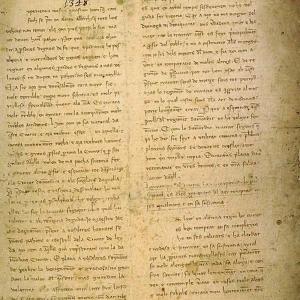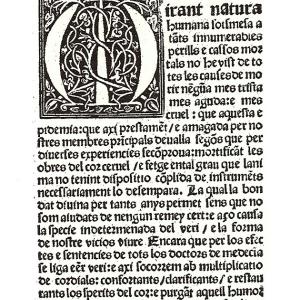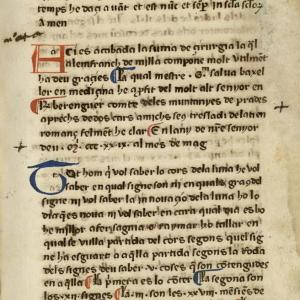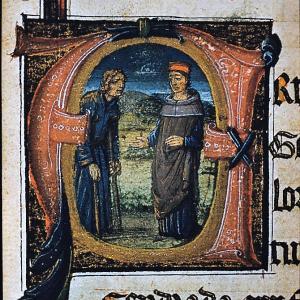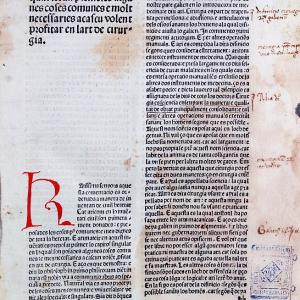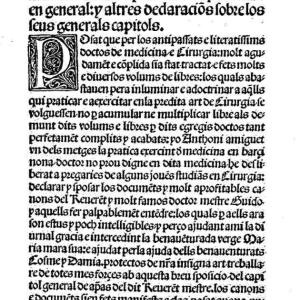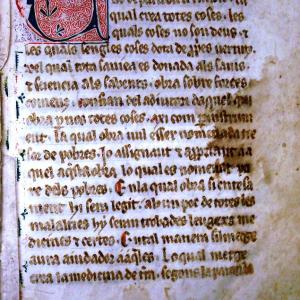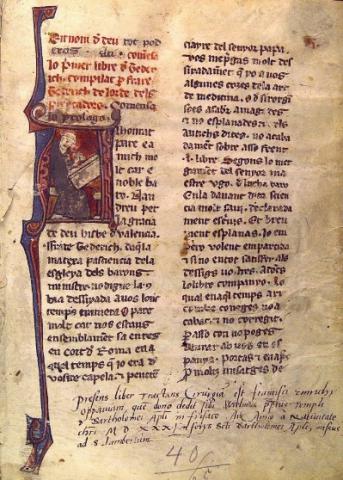
Medicine in Catalan, from the manuscript to the printing press
When Western Europe entered the period known as the late Middle Ages, Latin, the language of the Church, the university, law, administration, notaries and even high literature – of writing, in short – which had hitherto been used exclusively in all these areas, began to find itself being displaced by the spoken or vernacular languages, called “vulgar” in contrast to it. It is a historical process that in modern international research is called the “vernacularization” of knowledge, and which can be explained chiefly by the rebirth of urban society, which had disappeared at the end of Antiquity.
The “vernacularization” of knowledge also affected the entire extensive sphere of science and technology. Mediterranean Latin Europe, the first to be re-urbanized, led the way in the process, which began in the thirteenth century, but it spread to the whole of Western Europe during the fourteenth and fifteenth centuries. In Catalan, a powerful movement producing translations of works of science and technology, and the writing of original ones, appeared from the closing stages of the thirteenth century onwards. Pride of place was given to everything to do with health (human and animal) and the natural sciences, interests that were logically pre-eminent in that new urban context.
Although this article is about the dissemination of works of medicine in Catalan, it is useful to bear in mind that they were not the only reflection of the pre-eminence of society’s interest in health and the dissemination of texts in Catalan on this subject, because works on other subjects, such as natural philosophy, alchemy, astrology and magic, with many testimonies in Catalan, were often based on that interest and had a strong medical orientation.
From at least the reign of James II (1291-1327) to the early sixteenth century, a large number of works of medicine were translated into Catalan. The overwhelming majority of the texts that circulated in Catalan were written belonging to the field of medicina practica (‘practical medicine’, that dealing with prevention and therapeutics). Notable among them were regimens of health, like the one that Arnald of Villanova wrote for James II; treatises on surgery, like the ones by Theodoric Borgognoni, Lanfranc of Milan and Guy de Chauliac (figs. 6-7 and 11-13); general compendia, for instance Bernard of Gordon’s Lilium medicine, the fourth book of Avicenna’s Canon (fig. 3) or Galen’s De ingenio sanitatis; compilations of practical remedies, like Tresor de pobres (‘The Treasury of the Poor’), attributed to Peter of Spain (Petrus Hispanus) (fig. 15); treatises on the plague, like those by Jaume d’Agramont or Lluís Alcanyís (figs. 9-10), or the herbarium known as Màcer (fig. 4), to name but a few.
At the same time, total or partial Catalan translations of works of medicina theorica (‘theoretical medicine’, the Hippocratic-Galenist doctrinal corpus of medicine) began to appear: Johannitius’ Isagoge (of which commentaries in Catalan were also in circulation) (fig. 1), Hippocrates’ Aphorisms (fig. 2), and texts concerning prognosis and diagnosis, such as Philaret’s De pulsibus, among others.
A large number of these translations were made from the Latin version, even those of some works by Arab authors, such as the Liber Almansoris by Al-Rāzī (Rhazes, Rasis). Here we should mention two characteristic aspects that make the spread of medicine in Catalan during the period especially complex. On one hand, and as in other Iberian languages, the existence of a large number of texts translated from Arabic; on the other, the presence of translations of some very important writings in the sphere of university medicine that did not apparently circulate in other vernacular languages.
Moreover, one can also detect the use of Catalan as a bridging language in the translation process from Arabic into Latin, a habitual method in the transmission of knowledge in the territories on the frontier between Latin Europe and the Arab world. Explicit examples of them have been pointed out, such as the part of Kitāb al-taṣrīf by Al-Zahrāwī (Albucasis, Abulcasis) relative to the diets of the sick, made before 1318 by Berenguer Eimeric, a university doctor from Valencia, a Catalan translation that is now lost. There may well be more Catalan examples of this method that have not been studied or simply identified, given that the Catalan-Aragonese sphere of influence acted as a conduit for the transmission of Arab Andalusian medical culture to the University of Montpellier.
Indeed, there are still more cases of Catalan translations made from Arabic about which we do not know whether they were conceived or used that way. In the first place there is the translation of an unidentified Arabic medical text that James II ordered in 1296 from his Jewish doctors Vidal Benvenist Saporta and Benvenist ben Benvenist. Then there is the one that the same monarch ordered in 1313 from his faqīh, doctor and Arabic interpreter, Jafudà Bonsenyor, also Jewish, of another part of Al-Zahrāwī’s Al-taṣrīf, very probably referring to surgery. Or the Liber de oculis (‘Book of Eyes’) by Al-Qūṭī (Alcoati), that Joan Jacme “explained from Arabic into [Catalan] Romance” (fig. 8). Other works could also be added to the list, like Speculum al foderi (‘The Mirror of Coitus’), a compendium of sexual hygiene and advice about (male) sexuality based on Latin and Arabic texts.
The writing of original works in Catalan began in the first half of the fourteenth century. The oldest ones that we have so far been able to identify are the commentary that Guillem Salvà, the infant Ramon Berenguer’s doctor, added to his translation of Lanfranc of Milan’s Chirurgia parva (‘Minor Surgery’), dated 1329, and the treatise on phlebotomy unquestionably written by the same doctor in that year (fig. 11).
These works, which have yet to be studied, stand alongside what has hitherto been considered to be the oldest, the Regiment de preservació de pestilència (‘Regimen of Preservation from the Plague’) that the university doctor and professor of the faculty of medicine in Lleida, Jaume d'Agramont, finished on 24 April 1348, shortly before he died of the Black Death (fig. 9). This treatise on the plague is important for being one of the earliest European medical treatises written in this genre, for the non-university urban context that originated it, and for the elaborate astrological arguments that the author puts forward in it. As Agramont himself explains in the foreword, he wrote the Regiment not to instruct university educated doctors, but to show the population of Lleida as a whole how to avoid this new disease that was then threatening the city, and which would kill him. To make himself understood by the readers he wanted to reach, Agramont chose to use the vernacular language and not the academic one. The municipal council – the dynamic social sector of the bourgeoisie – to which Agramont addressed the work, received it enthusiastically and arranged for his widow to receive a pension.
It is not surprising, due to the demand for them in the cities and towns, that another treatise on the plague, the Regiment preservatiu i curatiu de la pestilència (‘Regimen for Self-preservation and Cure of the Plague’) by the Valencian Lluís Alcanyís (Valencia, c. 1490) (fig. 10), should have been the first medical work originally written in Catalan to be printed, and that this genre would have a long life in this language, as we shall see.
And yet it is a fact that no great works of medicine were written in Catalan. We could add a few texts on medical astrology or the treatises on diagnosis based on the pulse and urine dubiously attributed to Antoni Ricard, King Martin’s doctor.
A different case altogether are the books of medical prescriptions, a large number of which were written and have been conserved, both “professional” ones, written by non-university trained medical practitioners for use in their work, and “domestic” ones, produced by non-medical people for personal or family self-help (fig. 5). It is a very important medical genre because it is the only one in which one detects the “vernacular” writing of medical knowledge, not just because of the language that was mainly used in them, but because they were conceived and written from outside the university institution. These prescription books met an inherent need in society, which had a seriously limited health system, and they survived until the appearance of the welfare state. They were composed mostly of prescriptions – of which, moreover, a huge number of those copied here and there are conserved, whose origins, oral or written, are very hard to trace – but also of complementary small practical booklets that provided a guide for the diagnosis and prognosis of diseases, the time to perform bleeding, moral behaviour, amusement, and so on.
To find out why so many works like these were disseminated in Catalan – some of them quite exceptional in European vernacular writing – during this period of history and why the presence of medicine is so overwhelming among the non-literary and non-religious works that circulated in Catalan from the late thirteenth to the early sixteenth century, it is necessary to analyse who they were written for, namely, the people interested in them. The works themselves, or the indirect information about them that has survived in inventories of goods or other documents, show us that this market was split between two main parts.
On one hand, there were the individuals that worked as medical practitioners or in another health-related profession. This sector is divided into two groups:
- Surgeons, barber-surgeons and apothecaries, whose education was not academic but who obtained it in the “open system”, that of apprentices-officials-masters typical of crafts. They were in the majority among the individuals who looked after people’s health, and the only ones that most of the population could afford, if they had one nearby. This was the main target group and the professional market for the translations. They were very often also the promoters or authors of the most technical ones. The treatises on surgery were read mainly, but not solely, by surgeons and barber-surgeons. Outstanding among these treatises on surgery, for the early translation and the extraordinary dissemination that it enjoyed in Catalan, is the one by Theodoric Borgognoni, translated in about 1304 by the surgeon from Majorca Guillem Corretger while he was a medical student at the University of Montpellier (fig. 6). This translation was revised and part of it was completely redone by a university doctor, Bernat de Barriac, a doctor of the kings of Majorca, in 1310 (fig. 7). Also very important, for the encyclopaedic scope of the work and for surviving in Catalan, one of the most beautiful manuscripts was the one by Guy de Chauliac, translated in the closing stages of the fourteenth century (fig. 12). For their part the apothecaries were interested in antidotaries (compilations of common formulae of compound medicines), like the translations of the one by Nicholas of Salerno or the one that circulated in the name of Arnald of Villanova, which have not survived, and reference books on simple medicines, like the ones by Ibn Wāfid and Platearius.
- University educated physicians and surgeons, in the minority and only affordable by a wealthy few. In their libraries, although the majority of the books were in Latin, as befitted their background, there were exceptionally also a few works in Catalan.
The other group consisted of individuals that did not practise medicine, but who were interested in it for cultural reasons, or in search of social advancement, and also to ensure domestic self-help for themselves. In this sector, there are three groups:
- Kings and other members of the royal family, in the Catalan context of that period firmly committed to supporting the new model of university doctor and medicine. They were another of the essential driving forces of the process, promoting translations, like that of the Regimen sanitatis ad regem Aragonum (‘Regimen of Health for the King of Aragon’) by Arnald of Villanova, commissioned by Queen Blanche of Anjou to Berenguer Sarriera, James II’s surgeon, in about 1308-1310, or some translations from Arabic, like those mentioned above. But above all they were essential because their attitude and involvement gave rise to the subtle mechanism of imitation among the faithful and the ambitious.
- The nobility, the first link in this chain of imitations. They promoted translations, like that of Lanfranc of Milan’s Chirurgia parva for the infant Ramon Berenguer, Count of The Mountains of Prades, by its translator and commentator, Guillem Salvà, and these works could be found among their books, as in the case of Hug de Santapau (Avicenna’s Quart del Cànon, ‘Fourth Book of the Canon of Medicine’).
The bourgeoisie, the last and most important link in this chain of imitations. In this context, one must include the plague treatises by Agramont, Velasco de Taranta and Lluís Alcanyís, addressed to municipal governments or engendered in urban environments, but almost certainly too, other anonymous works and translations, which they had in their well-stocked libraries.
The use of the vernacular in works of medicine was a very important instrument not only for expanding the education of non-university trained practitioners with works from the highly esteemed academic world, but also for ensuring their social control – bringing them into contact, with examinations and licenses, with the new model of medicine and doctors – and doing away with illegal practice. In fact, the vernacular was an important intellectual and social bridge that made it possible to unite the academic world, expressed in Latin, and that of the non-university educated doctors who did not know this language. They however saw that as no reason to be marginalized by a Galenism that showed itself to be effective on both a doctrinal and a practical level, providing them with prestigious knowledge, and on a socio-professional level, offering them unexpected opportunities for advancement. The use of the vernacular in these works is, then, a faithful testimony to the prestige and the dissemination of university medicine among non-university educated healers.
But it also reflects the prestige and the dissemination of this university medicine among readers who did not work in health-related professions, but who were educated and aware of the problems of health and disease, who had no Latin or simply preferred to use the vernacular: a non-medical readership comprising kings, noblemen and above all the bourgeoisie, who patronized many of the translations, and who actively accepted academic Galenism as the best system for ensuring the maintenance of individual and collective health.
For all these reasons it should come as no surprise that most of the works translated into the vernacular or written in it corresponded above all to the area of “practical medicine” (hygiene, surgery, pharmacology), or that the works of “theoretical medicine” that circulated in Catalan were also essentially practical (providing basic knowledge or methods of diagnosis), while Latin continued to be the undisputed vehicle of the scholastic university. Despite this, commentary, one of the methodological and didactic tools typical of the medieval university, was also represented in medical texts in Catalan. In fact, the universities got more involved in this process than has been supposed, furnishing it with the most highly esteemed translators and correctors.
With printing, Catalan continued to display great vitality in the dissemination of medicine: the Tractat de la epidèmia i de pestilència (‘Treatise on the Epidemic and the Plague’, Barcelona, 1475) by Velasco de Taranta, a translation into Catalan from the original Latin, was the first medical work to be printed in an Iberian language (reprinted in 1507).
If we look at the types of medical works and the like printed in Catalan in the last quarter of the fifteenth and the early sixteenth centuries, it can be seen that printing encouraged above all the spread of practical works: plague treatises, such as the above-mentioned ones by Lluís Alcanyís and Velasco de Taranta; and works of surgery, like the Inventari o col·lectori en la part cirurgical de medicina (‘Inventory or set of precepts in the surgical part of medicine’, Barcelona, 1492) (fig. 13) and Cirurgia petita (‘Minor Surgery’, Barcelona, 1508) by Guy de Chauliac, Cirurgia (‘Surgery’, Perpignan, 1503) by Pietro d’Argellata and Lectura sobre lo tractat segon del reverent mestre Guido lo qual tracta d’apostemes en general (‘Lecture on the second treatise by the reverend master Guy which deals with abscesses in general’, Barcelona, 1501) by Antoni Amiguet (fig. 14).
Although the majority of printed medical texts continued to be in Latin, printing gave rise – particularly in the case of the most widely spoken languages – to an authentic boom in translation into the vernacular, and in this way consolidated the definitive triumph of the model of university medicine and medical practitioners that had appeared two centuries earlier.
In Catalan, however, the translation and production of original works was virtually brought to a halt in the early decades of the sixteenth century as a consequence of a combination of political and social causes, arising above all from the court’s move to Castile as a result of the dynastic union of 1516. This brought about the end of the mechanism of imitations in favour of Catalan, with the consequent linguistic desertion of the dominant social groups, who had been its main economic driving forces.
In the early modern period, only the short informative medical works most in demand (practical astrology booklets and especially plague treatises) were printed in Catalan. The former users of works in the vernacular had to make do, whether they liked it or not, with editions in other languages (Latin, French, Italian and above all Castilian, which in the new situation had acquired a social prestige that eclipsed Catalan in these areas).
Some editions:
- A. Alberni (ed.), Speculum al foder, foreword by Lola Badia; apostil by Lluís Cifuentes, Bellcaire d'Empordà, Vitel·la, 2007
- J. Arrizabalaga (ed.), Lluís Alcanyís, Regiment preservatiu e curatiu de la pestilència, Barcelona, Barcino (Els Nostres Clàssics, B 28), 2008
- M. Batllori (ed.), Arnau de Vilanova: Obres catalanes, vol. 2 (Escrits mèdics), Barcelona, Barcino (Els Nostres Clàssics, A 56), 1947
- A. Carré (ed.), Hipòcrates, Aforismes: traducció catalana medieval, with the collab. of F. Llorens, Barcelona, Curial Edicions Catalanes - Publicacions de l'Abadia de Montserrat (Textos i estudis de cultura catalana, 76), 2000
- A. Carré (ed.), Girolamo Manfredi, Quesits o perquens (regiment de sanitat i tractat de fisiognomonia), Barcelona, Barcino (Els Nostres Clàssics, B 25), 2004
- A. Carré (ed.), Arnau de Vilanova, Regiment de sanitat per al rei d'Aragó - Aforismes de la memòria, Barcelona, Universitat de Barcelona, 2017
- A. Carré i L. Cifuentes (eds.), La traducció catalana medieval del Lilium medicine de Bernat de Gordon: estudi i edició del fragment conservat (llibre VII, Antidotari), London, Queen Mary, University of London: Medieval Hispanic Research Seminar (Papers of the Medieval Hispanic Research Seminar, 76), 2017
- L. Cifuentes (ed.), Abu-l-Salt de Dénia, Llibre de simples medecines, in Arnau de Vilanova, Translatio libri Albuzale de medicinis simplicibus, ed. by José Martínez Gázquez, Michael R. McVaugh, Ana Labarta, Lluís Cifuentes and Danielle Jacquart, Barcelona, Universitat de Barcelona - Fundació Noguera (Arnaldi de Villanova Opera Medica Omnia, XVII), 2004
- [J. Collell (ed.)], Pere Hispà, Tresor de pobres compilat per Pere Hispano (Papa Joan XXI): versió catalana del segle XIV, Barcelona, Impr. Fidel Giró (Biblioteca de la Revista Catalana), 1892 (unfinished ed.)
- L. Faraudo de Saint-Germain [pseudonym: Lluís Deztany] (ed.), Alcoatí, Libre de la figura de l'uyl, introduction by J. M. Simon de Guilleuma, Barcelona, Impr. "La Renaixença", 1933
- L. Faraudo de Saint-Germain (ed.), Ibn Wáfid, El ‘Libre de les medicines particulars', Barcelona, Real Academia de Buenas Letras de Barcelona, 1943
- L. Faraudo de Saint-Germain (ed.), "Una versió catalana del ‘Libre de les herbes' de Macer", Estudis Romànics, 5 (1955-1956), 1-54
- L. Ferre (ed.), ‘Práctica' de Johannes de Parma: un tratado farmacológico en sus versiones hebreas y catalana, Granada, Universidad de Granada, 2002
- E. Moliné i Brasés (ed.), "Receptari de Micer Johan", Boletín de la Real Academia de Buenas Letras de Barcelona, 7 (1913-1914), 321-336 i 407-440
- J. Perarnau i Espelt, "El receptari del sabadellenc Joan Martina (1439)", Arxiu de Textos Catalans Antics, 11 (1992), 289-328
- P. Vallribera i Puig (ed.), La Cirurgia Parva de Lanfranc (segle XIV), Manresa, Publicacions de l'Arxiu Històric de les Ciències de la Salut - Col·legi Oficial de Metges de Barcelona, 2002
- J. Veny (eds.), Jacme d'Agramont, Regiment de preservació de pestilència (Lleida, 1348), introd. by J. Arrizabalaga, L. García Ballester and J. Veny, Barcelona, Enciclopèdia Catalana, 1998
- J. Veny (ed.), Jacme d'Agramont, Regiment de preservació de pestilència (1348), introd. by Francesc Cremades; foreword by Xavier Luna-Batlle, Barcelona, Publicacions de l'Abadia de Montserrat (Scripta, 7), 2015
Selection of studies:
- L. Badia, Textos catalans tardomedievals i ‘ciència de natures', Barcelona, Reial Acadèmia de Bones Lletres de Barcelona, 1996
- J.-L. Bosc, Montpellier et la médecine andalouse au Moyen Âge: transfert des textes et des savoirs, foreword by L. Cifuentes, Montpellier, Presses universitaires de la Méditerranée, 2016
- M. Cabré i Pairet, "From a master to a laywoman: a feminine manual of self-help", Dynamis, 20 (2000), 371-393
- M. Cabré i Pairet, "Trota, Tròtula i Tròtula: autoria i autoritat femenina en la medicina medieval en català", in L. Badia, L. Cifuentes, S. Martí and J. Pujol (eds.), Els manuscrits, el saber i les lletres a la Corona d'Aragó, 1250-1500, Barcelona, Publicacions de l'Abadia de Montserrat (Textos i estudis de cultura catalana, 210), 2016, pp. 77-102
- L. Cifuentes, "Vernacularization as an intellectual and social bridge: the Catalan translations of Teodorico's Chirurgia and of Arnau de Vilanova's Regimen sanitatis", Early Science and Medicine, 4 (1999), 127-148
- L. Cifuentes, "La promoció intel·lectual i social dels barbers-cirurgians a la Barcelona medieval: l'obrador, la biblioteca i els béns de Joan Vicenç (fl. 1421-1464)", Arxiu de Textos Catalans Antics, 19 (2000), 429-479
- L. Cifuentes, "La literatura quirúrgica baixmedieval en romanç a la Corona d'Aragó: escola, pont i mercat", in L. Badia, M. Cabré and S. Martí (eds.), Literatura i cultura a la Corona d'Aragó (s. XIII-XV): Actes del III Col·loqui internacional Problemes i mètodès de literatura catalana antiga (Girona, 5-8 dejuliol de 2000), Barcelona, Curial Edicions Catalanes - Publicacions de l'Abadia de Montserrat (Textos i estudis de cultura catalana, 85), 2001, pp. 321-335
- L. Cifuentes, "Université et vernacularisation au bas Moyen Âge: Montpellier et les traductions catalanes médiévales de traités de médecine", in D. Le Blévec and Th. Granier (dirs.), L'Université de Médecine de Montpellier et son rayonnement (XIIIe -XVe siècles): actes du colloque international de Montpelllier organisé par le Centre de recherches et d'études médiévales sur la Méditerranée occidentale (Université Paul Valéry-Montpellier III), 17-19 mai 2001, Turnhout, Brepols, 2004, pp. 273-90
- L. Cifuentes, La ciència en català a l'Edat Mitjana i el Renaixement, Barcelona - Palma, Universitat de Barcelona - Universitat de les Illes Balears (Col·lecció Blaquerna, 3), 2006 (2nd rev. and enl. ed.)
- L. Cifuentes, "El receptari mèdic baixmedieval i renaixentista: un gènere vernacle", in L. Badia, L. Cifuentes, S. Martí and J. Pujol (eds.), Els manuscrits, el saber i les lletres a la Corona d'Aragó, 1250-1500, Barcelona, Publicacions de l'Abadia de Montserrat (Textos i estudis de cultura catalana, 210), 2016, pp. 103-160
- L. Cifuentes, "Les miscel·lànies mèdiques medievals en català: una proposta de classificació", in I. Müller and F. Savelsberg (eds.), Formació, organització i transmissió del saber a l'Edat Mitjana i al Renaixement, Berlin, Walter de Gruyter, forthcoming
- F. Ribas i Puntí, "L'ús del català en els tractats de pesta", Gimbernat, 9 (1988), 293-312
- J. Riera i Palmero, "Els incunables científics en llengua catalana", Gimbernat, 5 (1985), 313-320
- J. Samsó, "Traducciones científicas árabo-romances en la península Ibérica", in S. Fortuño Llorens and T. Martínez Romero (eds.), Actes del VII Congrés de l'Associació Hispànica de Literatura Medieval (Castelló de la Plana, 22-26 de setembre de 1997), vol. 1, Castelló de la Plana, Universitat Jaume I, 1999, pp. 199-231
- Relational database on medieval and early Renaissance Catalan works and translations of medicine, science and technology.
- Database of descriptions of medieval manuscripts and early printed books in Catalan on all subjects.
- Digital reproduction of some incunabula and early printed books and of modern editions.
Diccionari català-valencià-balear (DCVB)
- Historical and dialectal dictionary of the Catalan language, which includes a good sample of the specialized / technical vocabulary of medieval and modern medicine.
Vocabulari de la llengua catalana medieval
- Computerization of the files of medieval Catalan technical vocabulary by Lluís Faraudo de Saint-Germain.
1) vernacular / vulgar / plain / Romance
In late-medieval Western European society, in which Latin was the language of theology, public faith, the universities, science and high culture, the need arose to give a generic name to the commonly spoken language that was increasingly being incorporated into the world of writing. Although the name “Catalan” was fully in use, the spoken language was referred to generically, and always in contrast to Latin, with the expressions “vernacular”, “vulgar”, “plain” or “Romance”. In line with this, the act of translating into this language was indicated with the expressions explanar (explain) or arromançar (translate into Romance language).
2) vulgarization / vernacularization
There has been international agreement to call the process that arose in Europe in the late Middle Ages and the Renaissance, of transferring some of the knowledge to the spoken languages, “vernacularization”. This expression avoids the grave anachronism that would be entailed by the term “vulgarization”, because this process did not consist only of dissemination, as this expression currently suggests, but also of a complex use of university knowledge by non-university educated sectors, both those with no academic training who worked in practical professions and the laymen who for different reasons were interested in the subjects associated with these professions.
1. Johannitius (Ḥunayn ibn Isḥāq), Llibre d'introduccions a l'Art de la medicina de Galè (Isagoge ad Tegni Galieni), anonymous translation (Paris, BnF, MS Esp. 508, f. 1r).
2. Hippocrates, Aforismes, with Galen’s commentary, anonymous translation (Bordeaux, Bibliothèque [Municipale] Mériadeck, MS 568, f. 1r).
3. Avicenna (Ibn Sīnā), Quart llibre del Cànon de la medicina (‘Fourth Book of the Canon of Medicine’) anonymous translation (Paris, BnF, MS Esp. 563, f. 1r).
4. Odo de Meung (Ps.-Màcer), Llibre de les virtuts de les herbes (‘Book of the Virtues of Herbs’) (Valencia, BHUV, MS 216, f. 27ra).
5. Misser Joan, Llibre de receptes (‘Book of Prescriptions’) (Los Angeles, UCLA Louise M. Darling Biomedical Library, MS Benj. 1-4, f. 79v).
6. Theodoric Borgognoni, Cirurgia, translation by Guillem Corretger (Paris, BnF, MS Esp. 212, f. 1r).
7. Theodoric Borgognoni, Cirurgia, translation by Guillem Corretger revised [and partially redone] by Bernat de Berriac (Graz, Karl-Franzens-Universitätsbibliothek, MS 342, f. 1r).
8. Alcoatí (al-Qūṭī), Llibre de la figura de l'ull (‘Book of the Eye’s Shape’), translation by Joan Jacme (Zaragoza, Biblioteca Capitular de la Catedral de Zaragoza, MS 25-62 [formerly 1265], f. 6r).
9. Jaume d’Agramont, Regiment de preservació de pestilència (Verdú, Arxiu Parroquial, MS s/n, f. 1r).
10. Lluís Alcanyís, Regiment preservatiu i curatiu de la pestilència (Valencia, Nicolau Spindeler, c. 1490, f. a2r).
11. Colophon by Guillem Salvà to his translation and commentary of Lanfranc of Milan’s Chirurgia parva (Summa de cirurgia) and the beginning of his treatise on phlebotomy (Madrid, BNE, MS 10162, f. 54r).
12. Guy de Chauliac, Inventari o col·lectori en la part de cirugia de la medicina, anonymous translation (Vatican, Biblioteca Apostolica Vaticana, MS Vat. lat. 4804, f. 27r).
13. Guy de Chauliac, Inventari o col·lectori en la part cirurgical de medicina (Barcelona, Pere Miquel, 1492, f. a1r).
14. Antoni Amiguet, Lectura sobre lo tractat segon del reverent mestre Guido, lo qual tracta d'apostemes en general (Barcelona, Joan Luschner, 1501, f. a2r).
15. Peter of Spain, Tresor de pobres (‘The Treasury of the Poor’), anonymous translation (Vic, ABEV, MS 191, f. 5r).
Translated by Andrew Stacey, 23/10/2017
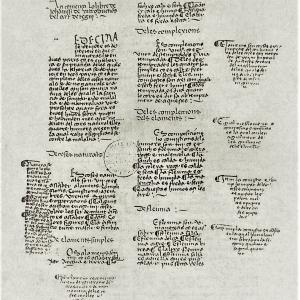
![2. Hippocrates, 'Aforismes', with Galen’s commentary, anonymous translation (Bordeaux, Bibliothèque [Municipale] Mériadeck, MS 568, f. 1r). 2. Hippocrates, 'Aforismes', with Galen’s commentary, anonymous translation (Bordeaux, Bibliothèque [Municipale] Mériadeck, MS 568, f. 1r).](/sites/default/files/styles/q_300/public/2017-12/aforismes_bordeus_0.jpg?h=9b89810e&itok=yz1Odizx)
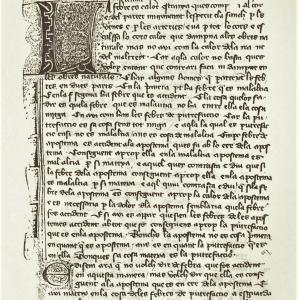
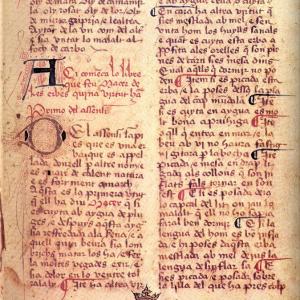
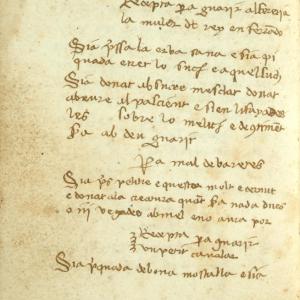
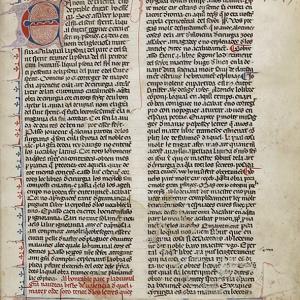
![7. Theodoric Borgognoni, 'Cirurgia', translation by Guillem Corretger revised [and partially redone] by Bernat de Berriac (Graz, Karl-Franzens-Universitätsbibliothek, MS 342, f. 1r). 7. Theodoric Borgognoni, 'Cirurgia', translation by Guillem Corretger revised [and partially redone] by Bernat de Berriac (Graz, Karl-Franzens-Universitätsbibliothek, MS 342, f. 1r).](/sites/default/files/styles/q_300/public/2017-12/teodoric_mbernat.jpg?h=f13ebd4b&itok=2H9WLrGi)
![8. Alcoatí (al-Qūṭī), 'Llibre de la figura de l'ull' (‘Book of the Eye’s Shape’), translation by Joan Jacme (Zaragoza, Biblioteca Capitular de la Catedral de Zaragoza, MS 25-62 [formerly 1265], f. 6r). 8. Alcoatí (al-Qūṭī), 'Llibre de la figura de l'ull' (‘Book of the Eye’s Shape’), translation by Joan Jacme (Zaragoza, Biblioteca Capitular de la Catedral de Zaragoza, MS 25-62 [formerly 1265], f. 6r).](/sites/default/files/styles/q_300/public/2017-12/alcoati_ull.jpg?h=9d418aed&itok=yO8noY1r)
